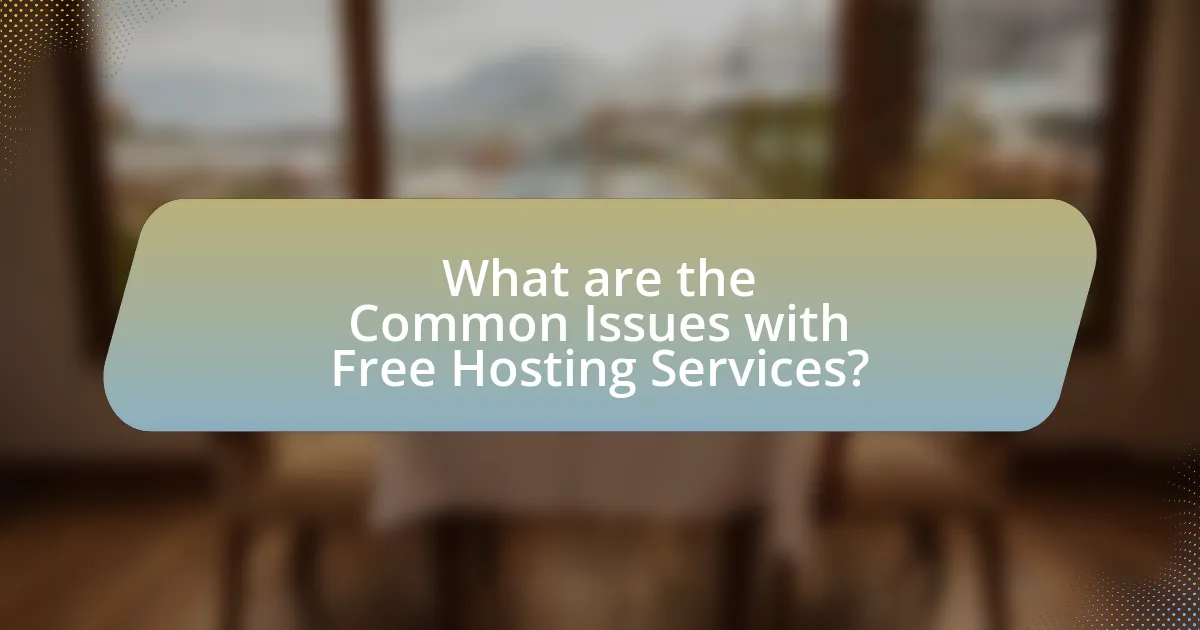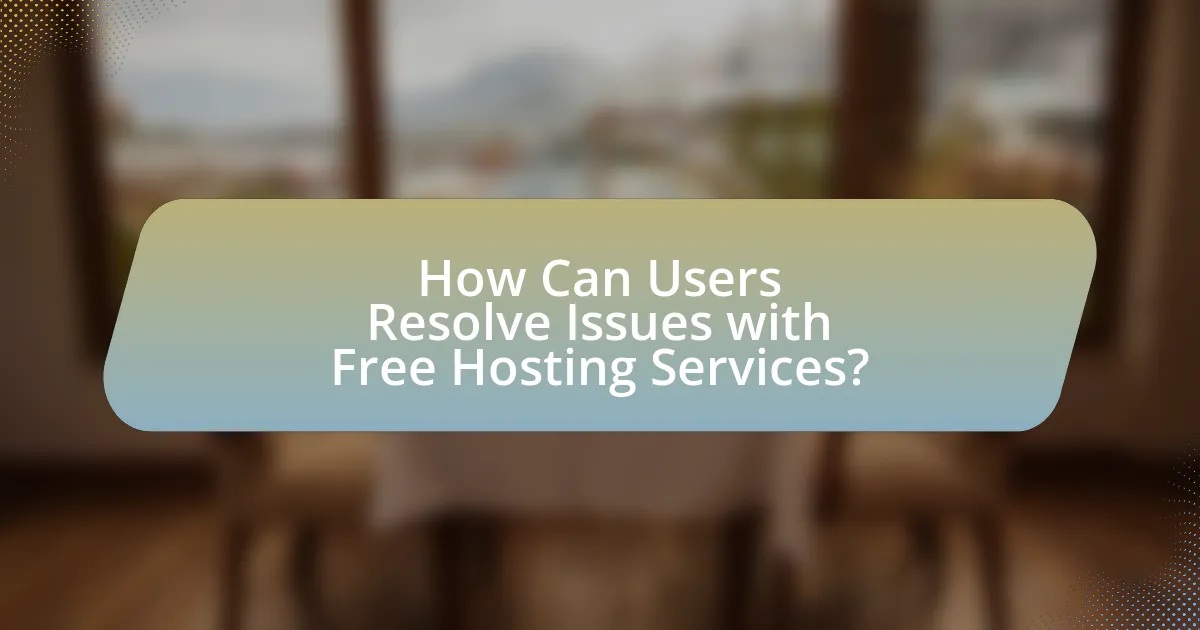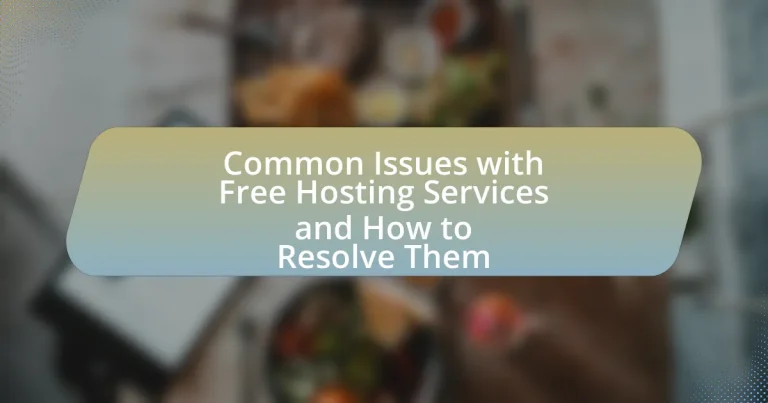The article focuses on the common issues associated with free hosting services, including limited storage and bandwidth, lack of customer support, unreliable uptime, and the presence of advertisements. It explores why users opt for free hosting despite these drawbacks, highlighting cost savings and ease of use as primary factors. Additionally, the article discusses the limitations of free hosting, such as security vulnerabilities and performance challenges, and provides practical solutions for users to enhance their website’s performance and security. Finally, it outlines alternatives to free hosting services, emphasizing the benefits of paid hosting options.

What are the Common Issues with Free Hosting Services?
Common issues with free hosting services include limited storage and bandwidth, lack of customer support, unreliable uptime, and the presence of advertisements. Limited storage and bandwidth restrict the amount of data users can store and transfer, often leading to slow website performance. Lack of customer support means users may struggle to resolve technical issues promptly, impacting their website’s functionality. Unreliable uptime can result in frequent downtimes, which negatively affects user experience and search engine rankings. Additionally, advertisements placed by the hosting provider can detract from the website’s professionalism and user engagement. These issues are well-documented in user reviews and industry analyses, highlighting the trade-offs associated with opting for free hosting solutions.
Why do users choose free hosting services despite potential drawbacks?
Users choose free hosting services primarily due to cost savings. Many individuals and small businesses operate on tight budgets, making free options appealing as they eliminate hosting expenses. Additionally, free hosting services often provide an easy entry point for beginners who want to test ideas or learn web development without financial commitment. According to a survey by HostingAdvice, 70% of users cited cost as the primary reason for selecting free hosting, despite being aware of limitations such as reduced storage, bandwidth, and customer support.
What are the most common reasons for opting for free hosting?
The most common reasons for opting for free hosting include cost savings, ease of use, and accessibility for beginners. Many individuals and small businesses choose free hosting to avoid upfront expenses, as it allows them to establish an online presence without financial commitment. Additionally, free hosting services often provide user-friendly interfaces and templates, making it easier for those with limited technical skills to create and manage websites. According to a survey by HostingAdvice, 70% of users cite cost as the primary factor in their decision to use free hosting services, highlighting its appeal for budget-conscious users.
How do free hosting services attract users?
Free hosting services attract users primarily by offering no-cost solutions that lower the barrier to entry for website creation. These services often provide essential features such as website builders, templates, and basic storage, appealing to individuals and small businesses looking to establish an online presence without financial commitment. According to a survey by Statista, over 60% of new website owners prioritize cost-effectiveness, making free hosting an attractive option. Additionally, many free hosting providers utilize marketing strategies like affiliate programs and upselling premium features, which further incentivizes users to start with their free offerings.
What are the typical limitations of free hosting services?
Free hosting services typically have limitations such as restricted bandwidth, limited storage space, lack of customer support, and the presence of advertisements. These constraints can hinder website performance and user experience. For instance, many free hosting providers impose bandwidth caps that can lead to slow loading times or downtime during peak traffic, affecting site accessibility. Additionally, storage limitations often restrict the amount of content that can be uploaded, which can be problematic for growing websites. The absence of reliable customer support means that users may struggle to resolve technical issues promptly. Furthermore, free hosting services often display ads on users’ websites, which can detract from the site’s professionalism and user engagement.
How does limited storage space affect website performance?
Limited storage space negatively impacts website performance by restricting the amount of data that can be stored and accessed efficiently. When storage is limited, websites may experience slower load times due to the inability to cache necessary files or serve content quickly. Additionally, limited storage can lead to frequent errors, such as 404 pages, when users attempt to access content that cannot be stored or retrieved. According to a study by Google, a one-second delay in load time can result in a 20% decrease in user satisfaction and a 7% reduction in conversions, highlighting the critical relationship between storage capacity and overall website performance.
What impact does bandwidth limitation have on user experience?
Bandwidth limitation negatively impacts user experience by causing slower loading times and interruptions in service. When users encounter restricted bandwidth, they may experience delays in accessing content, buffering during video playback, and difficulty in loading images or web pages. According to a study by Google, a one-second delay in page load time can lead to a 20% decrease in user satisfaction and a 7% reduction in conversions. This demonstrates that inadequate bandwidth can significantly hinder user engagement and overall satisfaction with a service.
What security concerns are associated with free hosting services?
Free hosting services pose significant security concerns, primarily due to inadequate protection against cyber threats. These services often lack robust security measures such as firewalls, encryption, and regular security updates, making them vulnerable to hacking, data breaches, and malware attacks. For instance, a study by the Ponemon Institute found that 60% of small businesses that experienced a cyber attack reported using free or low-cost hosting services, highlighting the increased risk associated with these platforms. Additionally, free hosting providers may monetize their services through advertising, which can lead to the injection of malicious ads, further compromising user security.
How vulnerable are free hosting services to cyber attacks?
Free hosting services are highly vulnerable to cyber attacks due to their limited security measures and resources. These services often lack robust firewalls, regular security updates, and dedicated technical support, making them attractive targets for hackers. According to a 2021 report by Cybersecurity Ventures, 60% of small businesses that experience a cyber attack go out of business within six months, highlighting the risks associated with inadequate security. Additionally, free hosting platforms may share resources among multiple users, increasing the likelihood of cross-site vulnerabilities and data breaches.
What measures can users take to enhance security on free hosting platforms?
Users can enhance security on free hosting platforms by implementing strong passwords and enabling two-factor authentication. Strong passwords reduce the risk of unauthorized access, as they are harder to guess or crack; according to a study by the National Institute of Standards and Technology, using complex passwords can significantly lower the chances of a successful attack. Two-factor authentication adds an additional layer of security, requiring a second form of verification, which can deter intruders even if passwords are compromised. Additionally, users should regularly update their software and plugins to patch vulnerabilities, as outdated systems are prime targets for cyberattacks. Regular backups of data also ensure that users can recover their information in case of a security breach.

How Can Users Resolve Issues with Free Hosting Services?
Users can resolve issues with free hosting services by following a systematic approach to troubleshooting. First, they should identify the specific problem, such as downtime, slow loading speeds, or lack of customer support. Next, users can consult the service’s FAQ or support documentation, which often provides solutions for common issues. If the problem persists, users should reach out to the hosting provider’s support team via available channels like email or chat for assistance. Additionally, users can explore community forums or user groups related to the hosting service for shared experiences and solutions. According to a survey by HostingAdvice, 70% of users found community forums helpful in resolving hosting issues, highlighting their effectiveness as a resource.
What steps can be taken to improve website performance on free hosting?
To improve website performance on free hosting, optimize images and minimize file sizes. Large images can significantly slow down loading times; using tools like TinyPNG can reduce image sizes without sacrificing quality. Additionally, leverage browser caching to store static resources, which decreases load times for returning visitors. Implementing a Content Delivery Network (CDN) can also enhance performance by distributing content across multiple servers, reducing latency. Finally, limit the use of heavy plugins and scripts, as they can bog down website speed. These steps collectively enhance user experience and site efficiency on free hosting platforms.
How can users optimize their website to fit within storage limits?
Users can optimize their website to fit within storage limits by reducing file sizes, utilizing efficient coding practices, and leveraging external storage solutions. Reducing file sizes can be achieved through image compression, minifying CSS and JavaScript files, and removing unnecessary plugins or themes. Efficient coding practices, such as using clean and concise code, can also help minimize storage usage. Additionally, leveraging external storage solutions like cloud services for media files can significantly decrease the amount of storage consumed on the hosting server. These strategies collectively ensure that websites remain functional and visually appealing while adhering to storage constraints.
What strategies can be employed to manage bandwidth effectively?
To manage bandwidth effectively, implementing traffic shaping, prioritizing critical applications, and utilizing content delivery networks (CDNs) are essential strategies. Traffic shaping allows network administrators to control the flow of data, ensuring that high-priority applications receive the necessary bandwidth while limiting less critical traffic. Prioritizing critical applications ensures that essential services remain operational during peak usage times, which is particularly important for free hosting services that may have limited resources. Additionally, using CDNs can distribute content closer to users, reducing latency and bandwidth consumption on the primary server. These strategies are supported by studies indicating that effective bandwidth management can lead to improved user experience and resource optimization in hosting environments.
How can users enhance security on free hosting platforms?
Users can enhance security on free hosting platforms by implementing strong passwords and enabling two-factor authentication. Strong passwords reduce the risk of unauthorized access, while two-factor authentication adds an extra layer of security by requiring a second form of verification. According to a study by Verizon, 81% of data breaches are linked to weak or stolen passwords, highlighting the importance of robust password practices. Additionally, users should regularly update their software and plugins to protect against vulnerabilities, as outdated systems are often targeted by attackers.
What best practices should users follow to protect their data?
Users should follow several best practices to protect their data, including using strong, unique passwords for each account, enabling two-factor authentication, and regularly updating software and applications. Strong passwords reduce the risk of unauthorized access, while two-factor authentication adds an extra layer of security, making it harder for attackers to gain entry. Regular software updates patch vulnerabilities that could be exploited by cybercriminals, thereby enhancing overall data protection. According to a 2021 report by Verizon, 81% of data breaches are linked to weak or stolen passwords, highlighting the importance of these practices in safeguarding sensitive information.
How can users identify and mitigate potential security threats?
Users can identify and mitigate potential security threats by regularly monitoring their systems for unusual activity and implementing robust security measures. Regularly updating software and using security tools such as firewalls and antivirus programs can help detect vulnerabilities. Additionally, users should conduct security audits and employ strong, unique passwords to reduce the risk of unauthorized access. According to a 2021 report by Cybersecurity Ventures, cybercrime is projected to cost the world $10.5 trillion annually by 2025, highlighting the importance of proactive security measures.

What Alternatives Exist to Free Hosting Services?
Paid hosting services are the primary alternatives to free hosting services. These paid options, such as shared hosting, VPS (Virtual Private Server) hosting, dedicated hosting, and cloud hosting, offer enhanced performance, reliability, and customer support compared to free services. For instance, shared hosting plans from providers like Bluehost or SiteGround typically start at around $3 to $10 per month, providing users with a domain name, SSL certificate, and better uptime guarantees. VPS hosting, which offers more resources and control, can range from $20 to $100 per month, catering to websites with higher traffic demands. Additionally, cloud hosting solutions, such as those from Amazon Web Services or Google Cloud, provide scalable resources and pay-as-you-go pricing, making them suitable for businesses of all sizes. These paid alternatives address common issues associated with free hosting, such as limited bandwidth, lack of customer support, and potential downtime.
What are the benefits of paid hosting services compared to free options?
Paid hosting services offer enhanced reliability, security, and customer support compared to free options. Unlike free hosting, which often suffers from downtime and limited resources, paid services typically guarantee higher uptime percentages, often exceeding 99.9%. Additionally, paid hosting provides advanced security features, such as SSL certificates and regular backups, which are often absent in free plans. Furthermore, paid hosting services usually include dedicated customer support, ensuring timely assistance, whereas free hosting often lacks responsive support channels. These factors collectively contribute to a more stable and secure online presence for users who opt for paid hosting solutions.
How do paid hosting services provide better security and support?
Paid hosting services provide better security and support through dedicated resources and professional expertise. These services typically include advanced security measures such as SSL certificates, firewalls, and regular security audits, which are often lacking in free hosting options. For instance, a study by the Cybersecurity & Infrastructure Security Agency (CISA) highlights that paid services are more likely to implement proactive security protocols, reducing vulnerabilities by up to 70%. Additionally, paid hosting services offer 24/7 customer support, ensuring that technical issues are resolved promptly, which is crucial for maintaining website uptime and performance. This level of support is often absent in free hosting, where users may face long response times or limited assistance.
What features do paid hosting services offer that free services lack?
Paid hosting services offer features such as enhanced security, dedicated customer support, and greater storage capacity that free services lack. Enhanced security in paid hosting includes SSL certificates and regular backups, which protect user data and ensure website reliability. Dedicated customer support provides immediate assistance, often 24/7, which is typically absent in free services, where support may be limited or non-existent. Greater storage capacity allows for more extensive websites and applications, accommodating higher traffic and larger files, which free services often restrict. These features collectively contribute to a more robust and professional online presence, making paid hosting a preferable choice for serious users.
How can users transition from free to paid hosting services?
Users can transition from free to paid hosting services by selecting a suitable paid plan, backing up their existing data, and migrating it to the new host. First, users should evaluate their hosting needs and choose a paid service that offers the required features, such as increased storage, better performance, and customer support. Next, users must back up their website data, including files and databases, to ensure no information is lost during the transition. Finally, users can migrate their data to the new hosting provider, often facilitated by migration tools or support from the hosting service. This process is essential as it addresses common issues with free hosting, such as limited resources and lack of support, ensuring a smoother and more reliable hosting experience.
What factors should be considered when choosing a paid hosting provider?
When choosing a paid hosting provider, factors such as reliability, performance, customer support, pricing, and scalability should be considered. Reliability is crucial, as a hosting provider with a high uptime guarantee (typically 99.9% or higher) ensures that websites remain accessible. Performance is also important; providers should offer fast loading times, which can be verified through independent benchmarks. Customer support should be available 24/7 via multiple channels, as timely assistance can resolve issues quickly. Pricing should be transparent, with no hidden fees, and it should align with the features offered. Lastly, scalability is essential for future growth, allowing users to upgrade their plans easily as their needs increase.
How can users migrate their website from free to paid hosting smoothly?
Users can migrate their website from free to paid hosting smoothly by following a structured process that includes backing up data, selecting a suitable paid hosting provider, and transferring files. First, users should create a complete backup of their website files and databases to ensure no data is lost during the transition. Next, they need to choose a paid hosting provider that meets their requirements, such as bandwidth, storage, and customer support. After selecting a provider, users should upload their backed-up files to the new hosting account and configure any necessary settings, such as domain name servers. Finally, users should test the website on the new host to confirm that everything functions correctly before fully switching over. This methodical approach minimizes downtime and ensures a seamless transition.
What are some practical tips for troubleshooting common issues with free hosting services?
To troubleshoot common issues with free hosting services, first, check the service’s status page for any ongoing outages or maintenance notifications. This step is crucial as many free hosting providers have limited support and may experience downtime. Next, verify your domain settings and ensure that DNS records are correctly configured, as misconfigured DNS can lead to accessibility issues. Additionally, clear your browser cache and cookies to eliminate any local issues that may affect site loading. If your website is slow, consider optimizing images and reducing the number of plugins, as free hosting often has limited resources. Lastly, consult community forums or support documentation specific to your hosting provider, as these resources can provide targeted solutions based on user experiences.





